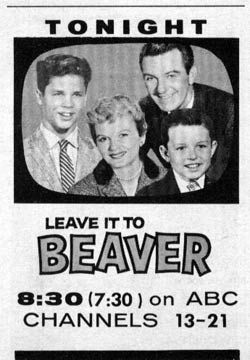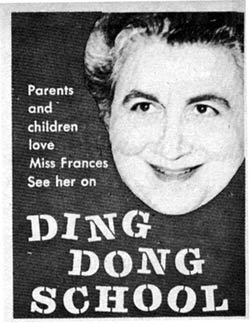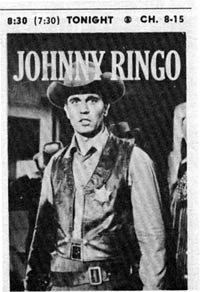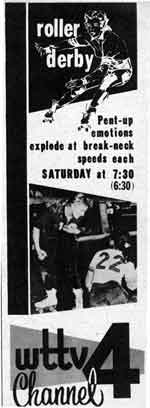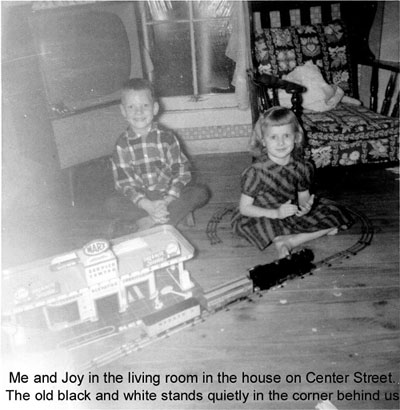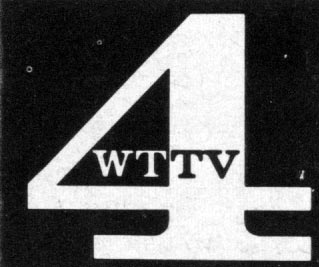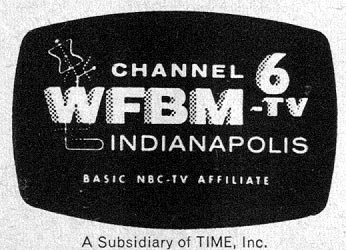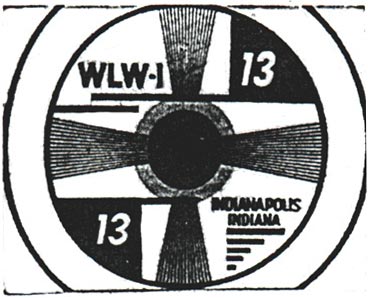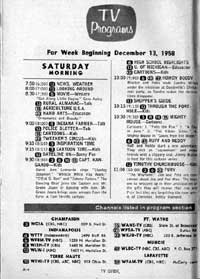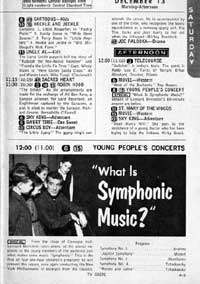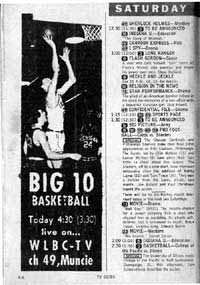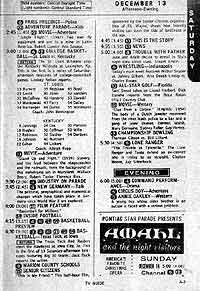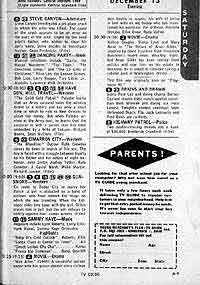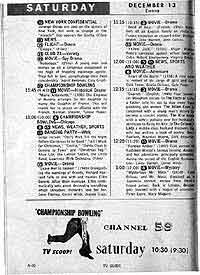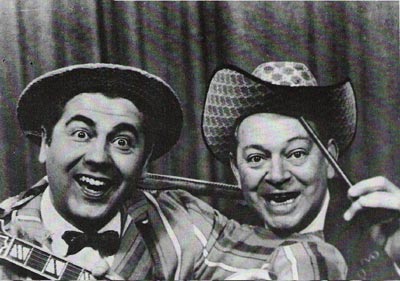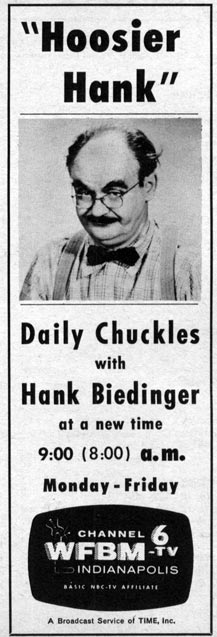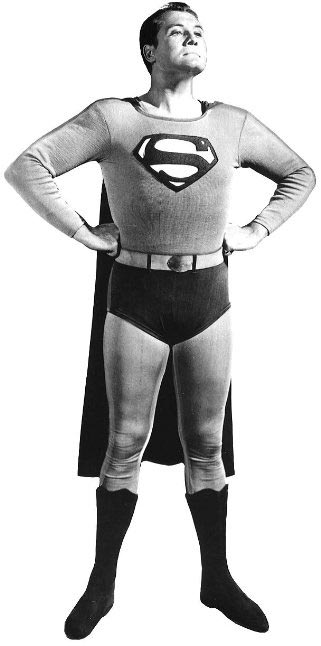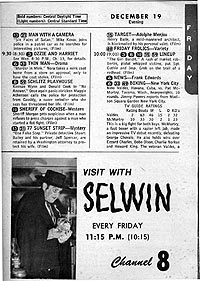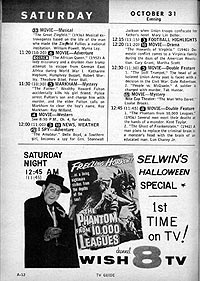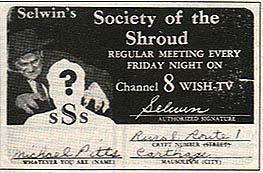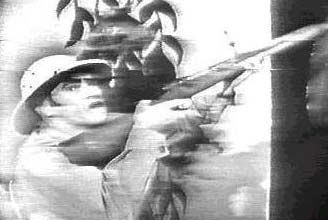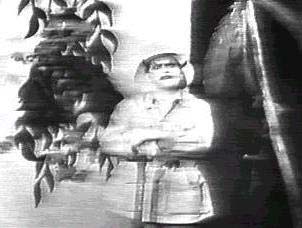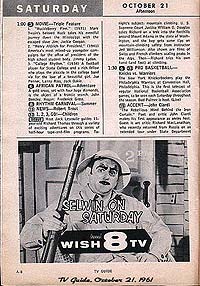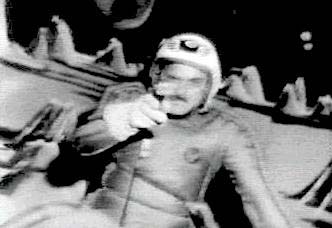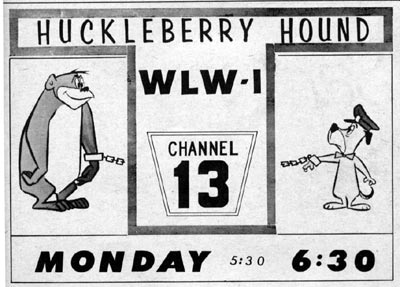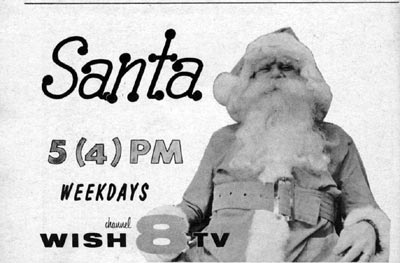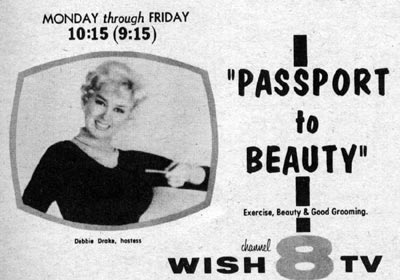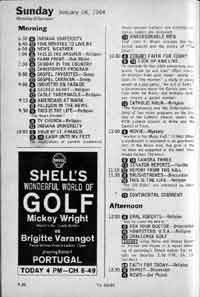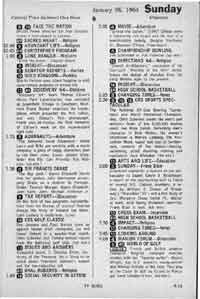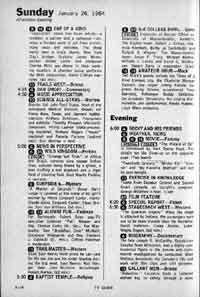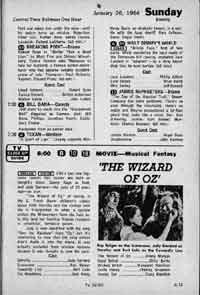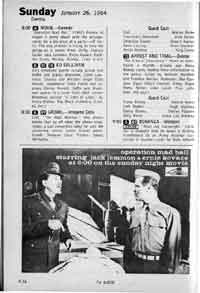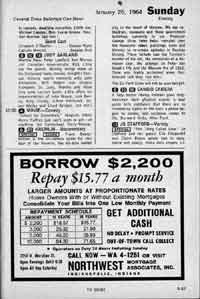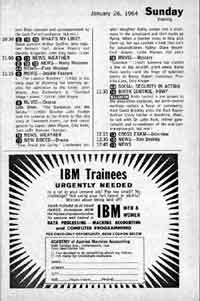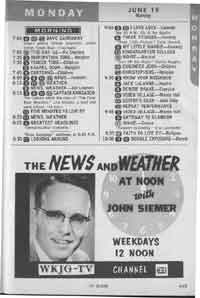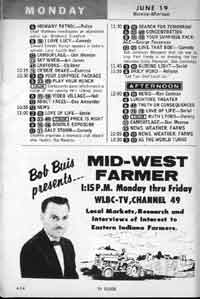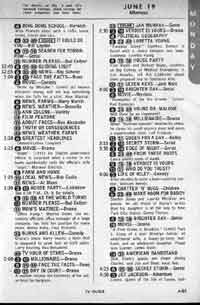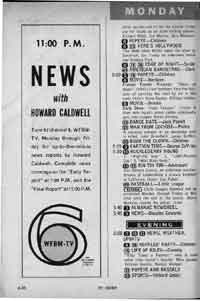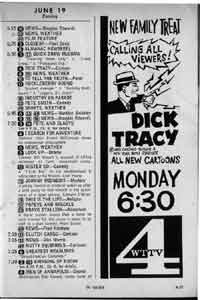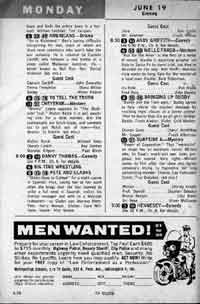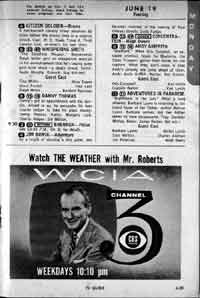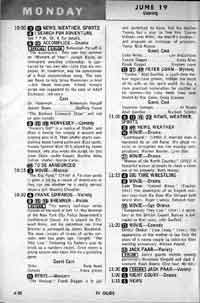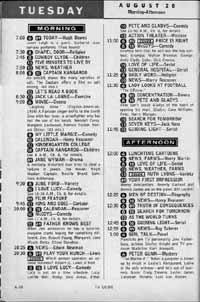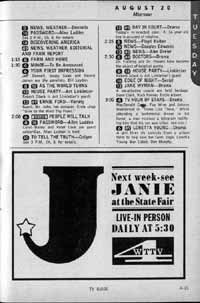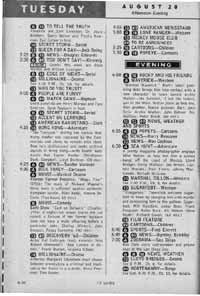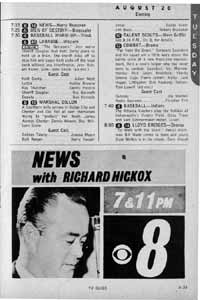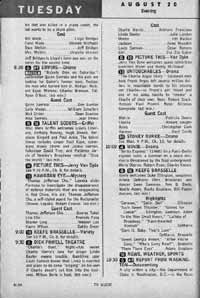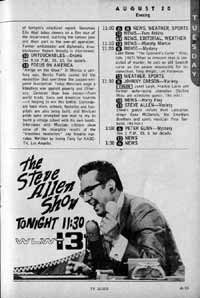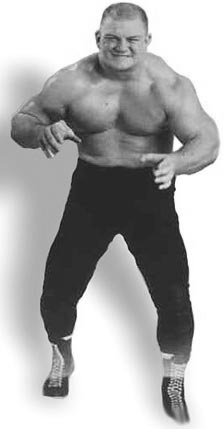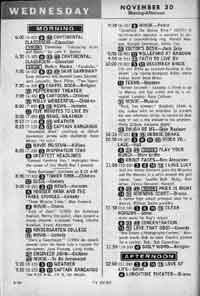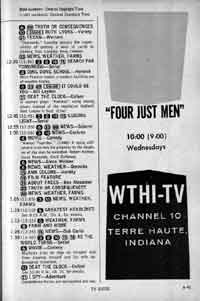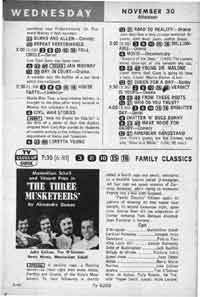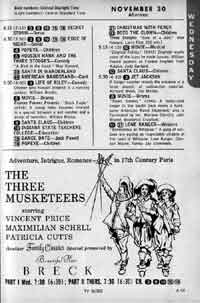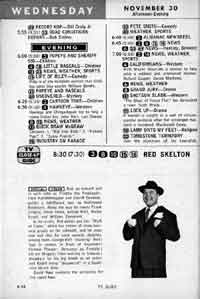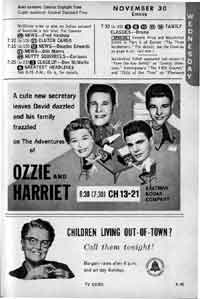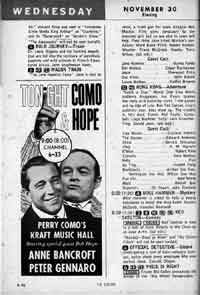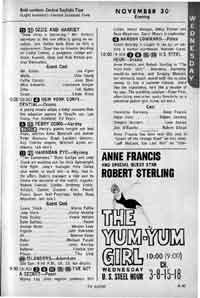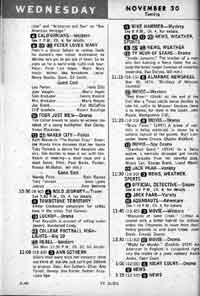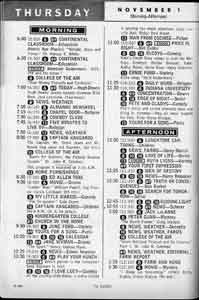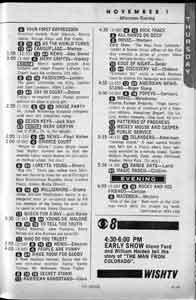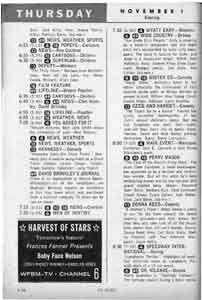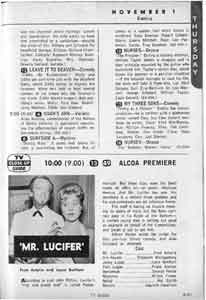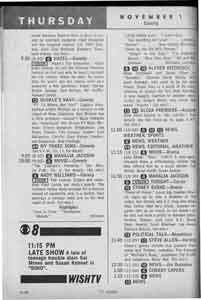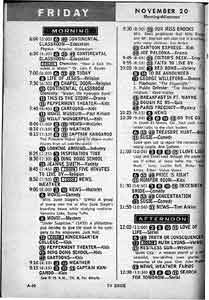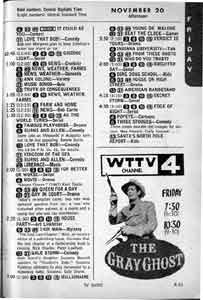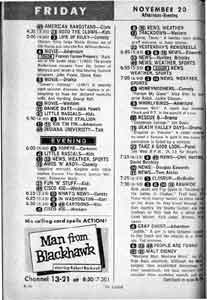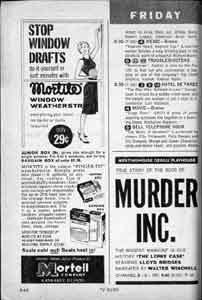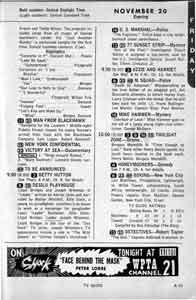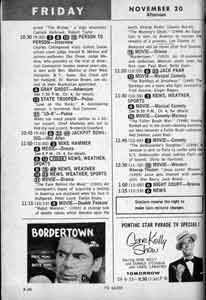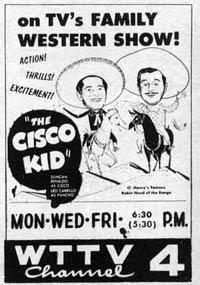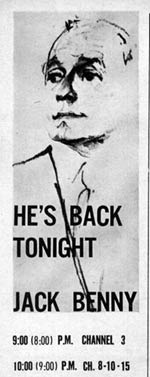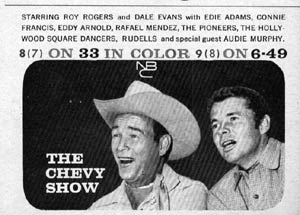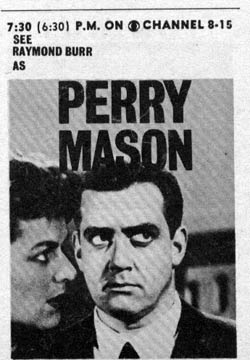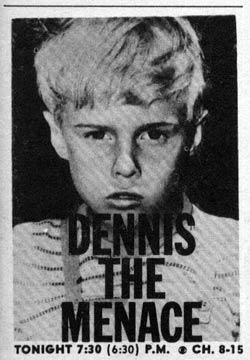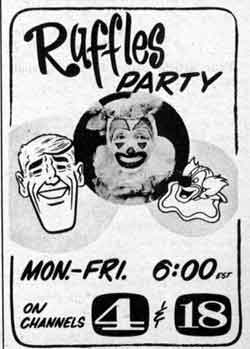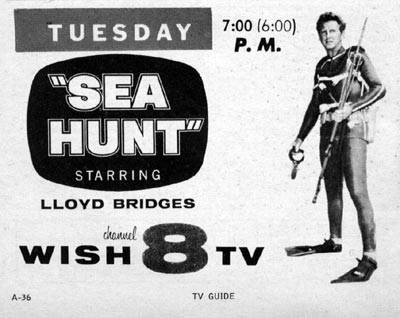|
What We Watched On Television |
||
|
The world, as I knew it, in the 1950's and 1960's consisted mainly of Center Street in East Columbus, State Street School, the surrounding neighborhood from Cherry Street to Hege, State Street to the railroad tracks, trips to the grocery store and downtown to shop, and an occasional movie at the Drive In or the Crump Theatre. I also "ventured outside" the boundaries of Columbus Indiana, however, through the magic of something called "the television set."
Television was still in its infancy once I was old enough to know which knob to pull to turn the tv set on and which knob to turn to change channels. Any memories of watching tv when we lived on Jackson Street are buried so deep within me that not even a wagon load of dynamite could expose them. Perry Mason couldn't pry them open with his best questioning techniques. So I choose to use the easy way out in writing this recollection. All tv memories begin when we lived on Center Street.
In 1947, RCA produced 170,000 black and white tv sets for mass consumption (with the population of the United States coming in a little over 144,000,000 people, not even one percent of us even owned a television set in 1947!). Considering the fact that Channel 6 (WFBM-TV, now known as WRTV) was the first station to sign on and broadcast over our local airwaves on May 30, 1949, I expect that none of those 1947 RCA sets were sold in Columbus Indiana.
That very first Channel 6 broadcast was a look back at the history of the Indianapolis 500, followed by coverage of the race for that year using three cameras, all set up on the main stretch. It was the first and only time the race would be broadcast "free" and live (the Indy 500 wouldn't be broadcast again until the Pay Per View channels came of age). Channel 6 was an affiliate of both CBS and ABC, and would remain that way until it became the sole affiliate for ABC in 1979. Channel 4 (WTTV-TV), an independent station, debuted its first broadcast on November 11, 1949. When WTTV-TV first began broadcasting, it was on Channel 10, but made the move to channel 4 on February 21, 1954, at 7:30pm. Channel 8 (WISH-TV) signed on the air on July 1, 1954. When WISH-TV first signed on, it was an affiliate for ABC, NBC, CBS, and the Dumont network. It wasn't until 1956 that WISH-TV's primary affiliate became CBS. Channel 13 (WLWI-TV, now WTHR) was the last Indy station, signing on the air on October 30, 1957. WLWI was the ABC affiliate .
Besides being affiliates for the major three networks (ABC,CBS,NBC), the Indianapolis channels also offered their own local programming. Each station had their own libraries and live shows, thus, the daily television offerings for the Columbus Indiana area (TV Guide, Central Indiana region) were different from Fort Wayne, Terre Haute, Lafayette, Muncie, or the rest of the United States for that matter. Most prime time programming was done on a national basis, thus if Ed Sullivan came on at 8:00pm Sunday night in the Columbus area, it also did so across the country (different time zones a given here).
The single, most important date associated with television appeal to a mass audience in these early years was September 30, 1947, with the first telecast of the World Series, featuring the New York Yankees and the Brooklyn Dodgers. 3.9 million viewers watched this series on tv, with 3.5 million people watching from bars! Full scale commercial television had begun!
The black and white television set that sat in the corner of our living room on Center Street was no different from the majority of tv sets sitting in living rooms across Columbus Indiana in the mid to late 1950's. A picture tube enclosed in a wooden case that sat on legs, a single knob to change channels, and a push-pull knob to turn the set on and off. Color tv? Uh...no. Color tv was still a rather new medium. Most people had just purchased their black and white sets and didn't want to fork over their hard earned money at this point in time for a new one. Plus, very few shows were broadcast in color. Color tv wouldn't take off until the early 1960's.
In order for a 1950's/1960's television set to work properly, it required an outside antenna, which was attached to a pole somewhere around the outside perimeter of the house (in our case, in the front yard, close to the living room where the tv set was). The pole was tall enough to clear the roof of the house, as well as most others in the neighborhood. Since tv signals were broadcast through the air, the antenna picked up whatever frequency the channel broadcast, sent the signal through the wire that ran from the antenna to the back of the tv set, and voila! We got a picture with sound. The antenna itself consisted of long and short pieces of fragile, hollow aluminum rods running parallel to one another and secured to a bracket that attached to the pole. Those who could afford it might have purchased a control box that sat on top of the tv. When the knob on the control box was turned, this sent a signal to the antenna to automatically turn it in the direction you wished. In those long ago Center Street days, I was the "control box" that turned the antenna. If you drive around any newer subdivision today, chances are pretty good you'll not see the first antenna jutting up above the rooftops.
Since our little town of Columbus Indiana was by no means a major metropolitan city, we watched shows and programs broadcast out of Indianapolis. Or let me put it this way: the strength of your aerial antenna dictated what channels you could pick up. In our case, living on Center Street, Indianapolis was about as far as we could venture out over the invisible airwaves and still get rather "good" reception. (Side note: I am sure that Columbus Indiana residents who had an excellent antenna could pick up stations out of Terre Haute and Louisville (our local TV Guide did not include listings for Louisville), but for the purposes of this article, what we watched is limited to the Indianapolis stations and the programs TV Guide listed for the Central Indiana region).
Many of the early television shows were borrowed from the popular radio shows that preceded tv as a major form of entertainment. The Life Of Riley (William Bendix held the role as Chester A. Riley on both radio and tv) Amos & Andy, the Jack Benny Show, and Gunsmoke (William Conrad did the voice for Matt Dillon on the radio program) are examples of popular shows that carried over from radio to tv.
By 1955, one-half of the homes in the United States had a black and white tv set sitting somewhere in the house (that's a far cry from less than one percent only 8 years before!).
On Saturday, September 10, 1955, at 10:00pm, well known actor John Wayne introduced a new series for CBS television audiences. Gunsmoke, starring James Arness as Matt Dillon, would run for the next 20 years. Gunsmoke set off a chain of adult western shows showcased during prime time for tv audiences in the 1950's and 1960's. Westerns peaked in popularity in the 1958-1959 tv season, with 31 westerns being shown during the weekly prime time schedule (and this doesn't include all the westerns that were shown in other time slots). Death Valley Days, Wagon Train, Have Gun Will Travel, Wanted--Dead Or Alive, Bonanza, Cimarron City, the Rifleman, Wyatt Earp, and Maverick are just a few of the westerns any Columbus Indiana resident could see during the week.
Those 1950's, 1960's days of watching tv seem so fresh and innocent from this current perspective. As the generation before me have fond memories of listening to the old radio shows of their era, my generation looks back with a nostalgic glint in their eye at those old black and white images that flickered into the hearts of our Columbus Indiana living rooms.
If I had to pick a favorite day to watch tv in 1958, I'd have to say it was Saturday. Saturday morning lineups were geared for kids, and with shows like Howdy Doody, Mighty Mouse, Ruff & Ready, Heckle & Jeckle, Roy Rogers, and Sky King, the mornings were pretty much consumed in front of the old black and white. Not being a huge sports fan at the age of 6, I watched very few sporting events on Saturday afternoons in 1958. This time was spent playing with Dallas Grimes and his sister Brenda, or Jimmy Fields, Charlie Grissom, and Chuck Zeigler. More time was spent indoors in the winter, of course, but not much afternoon time was spent in front of the tv until 5:00, when wrestling came on Channel 6. Wilbur Snyder and Dick the Bruiser were two of my favorite wrestlers.
Most Saturday nights were spent at my grandma's house, but usually we were back home in time to watch Have Gun Will Travel and Gunsmoke. No Late Shows for me at this early age. It would be another 3 years before I'd get hooked on those.
Kids today can't really appreciate what it was like to watch television back then. Channels devoted to one genre, like the Disney Channel, Nickolodeon, Boomarang, or the Cartoon Channel were unheard of. Tv stations and advertisers wanted to appeal to the mass audience and tried to do so within the confines of the three major (and only) networks. VHS or DVD? Those choices, as well as Blockbuster or Hollywood Video, were still someone's pipedream. TV stations didn't make it a habit of repeating the same movie very often. If you wanted to watch the Wizard Of Oz, it played in the Columbus Indiana area each January. If you missed it, you'd have to wait a year to see it again. Color tv? Well, yes if you wanted to include the various shades of blacks, grays, and whites that emanated from the tv tube. Ratings for tv weren't necessary. Everything was rated "M," which means it was up to MOM what we watched and what we didn't. We didn't need Congress imposing ratings guidelines for what we watched, or little icons in the top left of the screen denoting if a tv show was for mature audiences, or violent or had questionable language. If Mom didn't like me watching The Untouchables, she let me know so, and I didn't watch it (sometimes under extremely argumentative conditions). Lastly, we didn't have over 100 channels to choose from. We only had 4. Remote control? Fuggitaboutit! That's probably why most of us kids were sprawled out on the floor in front of the tv. That way, we didn't have as far to go to change the channel!
Most television storylines were simple, straight forward, and concluded at the end of the show. Very few prime time story lines were continued the following week, and that would remain so until Batman came along in 1967. Special effects were crude, and something rarely seen today: Quite a few of the shows were broadcast live.
All this stuff was beyond me in the late 50's/early 60's. All I knew is that I enjoyed certain shows within the offerings of the 4 channels we received. Channels 4 and 8 were the easiest to pick up. Channels 6 and 13 required some "fine tuning." In other words, I stepped outside and turned the antenna pole while my sister stood at the door, yelling at me to TURN LEFT, GO THE OTHER WAY, or STOP RIGHT THERE! Then it was back inside to watch whatever show was on.
All 4 channels signed on for the day and signed off after the day's programming was completed. Sign on normally consisted of a test pattern and tone, and sign off always included the playing of the Star Spangled Banner. Once you heard that last "...and the home...of the... brave," television broadcasting was finished until the next morning, unless you really couldn't fall asleep and wanted to watch gray and white snowy static.
Television was one of the main staples of many 1950's/1960's Columbus Indiana kids daily diet. Programs for children filled certain channels after school. Channel 4 offered the most selection, and once school and homework were finished, we enjoyed such programs as Popeye, Dick Tracy, and the Little Rascals. Channel 6 offered the 3 Stooges, and at 6:30pm, Huckleberry Hound came on Channel 13 ( all in 1959). After school programs varied with each new season. Some were local broadcasts, like Booby Trap (Saturdays at 1:00pm in 1964), a game show for local area kids, shown on Channel 8. This game show featured kids pulling those colorful round pieces out of the Booby Trap game board trying their best NOT to spring the BOOBY TRAP tension spring that held all the pieces together (the BOOBY TRAP game board and pieces used on the show were HUGE!) This program was based on the popular Milton Bradley game of the time. Each piece had a special prize printed on the reverse side, and if I remember correctly, the kids got to keep the prizes as long as they didn't spring the tension bar. Sorry, but I can't remember who the host of this show was.
Other local programs broadcast from the studios in Indianapolis included Santa Claus (between Thanksgiving and Christmas) at 4:30pm, on Channel 8, Popeye & Janie, and Cowboy Bob, both on Channel 4, Hoosier Hank, who hosted 3 Stooges after school on Channel 6, Curley Myers and Harlow Hickenlooper, who also hosted 3 Stooges shorts on Channel 6, Francis Farmer afternoon movie Monday through Friday on Channel 6, Ruffles Party on Channel 4, Friday night Fright Night horror host Selwin (Ray Sparenberg--Indianapolis' first horror host), on Channel 8, Sammy Terry and Wilhelmina on Channel 4, and Frank Edwards, who hosted a variety show on Channel 4 (Frank would go on to write several books (Stranger Than Science, Strangest Of All, Strange People, and Flying Saucers--Serious Business).
Other than the news, local programming has all but disappeared from our airwaves, and I miss that. The last time I remember seeing any local programming was during the blizzard of 1978, when Channel 8 stayed on the air all night long, and showed old Basil Rathbone/Nigel Bruce Sherlock Holmes movies while updating us on the blizzard conditions. I heard Mike Ahern say one time that none of the people working at Channel 8 couldn't get home that night and had to stay at the station. Someone dug up the old Sherlock Holmes movies to keep us entertained!
Almost every show broadcast in the 1950's and 1960's had a sponsor, and many of these sponsors were tobacco companies. It's a wonder that all of us who grew up during the 1950's/1960's didn't, or don't smoke. It wasn't unusual to see our favorite cartoon characters like Fred Flintstone and Barney Rubble lighting up a Winston on Friday nights right before the show ended. Sometimes Rod Serling had a smoke in his mouth while doing his intro to the Twilight Zone. And some shows sponsored by tobacco companies required that hosts smoke on the show. In those animated introductions to I Love Lucy, a cartoon Lucy and Desi smoked Phillip Morris cigarettes (call....for....Phillip....Morrrrrrrrrr--issssssssss). There were even cartoon characters used by the tobacco companies to advertise their product. The Chesterfield King (a lion) was usually surrounded by other cartoon character animals that promoted their "quality tobacco product." Tobacco companies would continue as major sponsors for tv shows until they were banned from tv on January 1, 1971. The last television commercial advertising cigarettes was for Benson & Hedges, shown on the Tonight Show.
In 1959, Channel 4 began showing The Adventures Of Superman at 6:30pm on Tuesdays. Superman, with George Reeves as the strange visitor from another planet who could change the course of mighty rivers and bend steel in his bare hands, had a powerful effect on me at the age of 7 (1959). There were many an evening that I would grab one of mom's towels after the show, tie it around my neck, and run and jump throughout the yard, trying my best to get off the ground for longer than a second or two (and keep the towel-cape tied around my neck). Part of the excitement of Superman was the beginning. The opening music (Superman Main Title) was an incredible piece of 58 seconds that excited me more than some of the episodes. Candy bars and cokes were no match for what that piece of music could do! Talk about getting a kid all wound up!
My favorite Superman episodes are those filmed in black and white. These episodes had much more action and "special effects" than the color shows for one simple reason: The color of Superman's costume. Blue was a terrible color to work with regarding the special effects techniques of the day, and made things too difficult to include much in the way of effects. Also, let's face it: we're not talking about a very high budget available for each episode. In the black and white shows, most of the main characters wore the same outfit all the time. This was so certain scenes could be used over and over in different episodes. The same scene of Clark Kent running into the alley, and the Superman flying sequences were used time and time again in many of the shows.
The death of George Reeves on June 16, 1959 shocked me as much as John Kennedy's assassination would some 4 years later. For a while, neighborhood rumors circulated through our group that George Reeves had actually believed he was Superman and jumped to his death, thinking he could really fly. It would be years later before I'd find out that the Man of Steel shot himself in the head. According to the coroner's verdict, George Reeve's death was listed as a suicide. Controversy still surrounds this verdict, and some people believe that "Superman" was actually murdered. As with the case of John Kennedy, we'll probably never find out what really happened, but George Reeves will always remain the one and only Superman in my eyes...
In the fall of 1958, Channel 8 picked up a movie package offered by Screen Gems (a subsidiary of Columbia Pictures) for late night, Friday night programming. This collection of movies was called the "Shock Package," and included old Universal horror films from the 1930's and 1940's. Frankenstein, Dracula, the Mummy, and the Wolf Man were but a few of the movies included in the package, introducing a new generation to the world of monsters and the undead. Many stations across the country picked up the Shock Package, and created local Horror Hosts to "host" each double feature. Dave Smith (who would later go on to host the show "When Movies Were Movies" on Channel 8), created Indianapolis' first Horror Host out of a Channel 8 program director by the name of Ray Sparenberg, better known to his tv Friday night audience as Selwin. The show was called Friday Fright Night and came on at 11:15pm (remember when the local news only ran for 15 minutes?). Many of the early Friday Fright Night shows were broadcast live out of the Channel 8 studio.
At the age of 6, I was much too young to be allowed to stay up late on Friday nights to watch Selwin and Friday Fright Night. I do remember catching him one late Friday after returning home from Grandma's house. There he was, ghoulish and strange in appearance (black and white made him appear more ghoulish), standing behind a working Lionel train set that had been assembled on a table in front of him, explaining the rules of a contest, and how he would give away the train set to some lucky boy or girl. I couldn't take my eyes off the train, and before I knew it, was told to go to bed. I wouldn't have another run-in with Selwin until early 1961, but would encounter my first "horror" film while home sick one school day in 1959/1960. Abbott & Costello Meet Frankenstein was shown on the Channel 6 morning movie, and while Mom washed clothes in the old ringer washer, I sat glued in front of the tv for the hour and a half, mesmerized by Frankenstein, Dracula, and the Wolf Man. The next day at school, Miss Thompson, my second grade teacher, let both myself and Terry Fogle (he was out sick too) sit on her desk in front of the class, and tell the kids about the movie and our movie experience. That movie began my life-long love affair with classic horror films.
Friday Fright Night and Selwin were widely popular in the Indianapolis area from 1958 through 1961. Selwin also had his own fan club, Selwin's "Society of the Shroud," but alas, I wasn't a card carrying member. During the showing of the first Halloween "Friday Fright Night" special in 1959 (it was broadcast live), Channel 8 announced a costume contest would be held at the studio. Thousands of people showed up, many more than seating allowed (the studio's capacity was 150), so the people had to be broken up into groups, with each group sitting through one segment of the show. Selwin poked fun at the advertisers of Friday Fright Night, and even had Vampira as a guest host on one show (besides being a Horror Host herself, Vampira was in the worst movie ever made: "Plan Nine From Outer Space," an Ed Wood film). The Friday Fright Night was so successful that Channel 8 picked up the Son Of Shock package and the program ran until early 1961.
In early 1961, Selwin traded his ghoulish costume (but kept the make-up) for a pith helmet and Jungle Jim type outfit, and began hosting Tarzan movies Friday nights on Channel 8. This was my first encounter with Selwin, as I had finally "come of age" (9 years old), and was allowed to stay up late. Friday nights quickly became my favorite night for television.
After working all week at Reliance Sportswear on Washington Street as a material cutter, Dad got paid on Fridays. That's when we did our grocery shopping. We shopped at the old Marsh supermarket on State Street (where Lo Bill's is today), and while Mom & Dad worked their way up and down the aisles, I closely inspected all the toys lined up on the shelves above the produce section. If I was lucky enough to get an allowance for the week (either 25 or 50 cents), my Friday night purchases for many weeks was a can of Durkee's Potato Sticks, and a bottle of Coca-Cola. The coke was put on ice, and the can of potato sticks remained closed until Selwin and Tarzan came on. Once the weekly shopping was completed, it was back in the car, drive home, unload the groceries, watch Rawhide, the Flintstones, the Twilight Zone, and after the news, Selwin and Tarzan. Some nights I thought 11:15 would never come.
Something as simple as staying up after everyone else had gone to bed brought so much joy to me (I was easy to please, I guess). With all the lights turned off, and my potato sticks and coke sitting on the floor beside me, those black and white images of Tarzan saving the elephant tusks from poachers, or saving Boy from a wild, stampeding rhinoceros, and fighting alligators, brought many an exciting night into that small living room on Center Street, and I look back on those nights now with many fond memories.
Sometimes after Tarzan had beaten the Nazis, or saved the pretty damsel in distress (in most cases, Jane), Channel 8 offered a science fiction movie before signing off. Godzilla and Rodan are two I remember watching.
In late 1961, Selwin was moved from Friday night to Saturday afternoons. He kept the outfit and hosted Tarzan and Bomba movies. The show was called "Selwin On Saturday."
Selwin moved back to Friday nights on April 13, 1962 and, for the last time, changed his jungle Jim outfit for a spacesuit. Channel 8 had picked up a run of science fiction movies, and once again, Selwin was the host. This was where I first saw THEM!, one of my most favorite sci-fi films, and Attack Of The Crab Monsters, although I never got any farther than the first 5 minutes of the movie. The scene where they pulled the guy's body out of the water with his head missing scared me so bad I shut the tv off and went straight to bed! Some 30 years later, I'd have the chance to see Attack Of The Crab Monsters again for the first time since that 1962 night, only to feel embarrassed by what had scared me so bad at the age of 10.
During the run of science fiction movies, Selwin decided he wanted to try and set a new record for the most non-stop roller coaster rides as a publicity stunt. He accomplished this at the old Riverside Amusement Park in Indianapolis, although I do not know how many hours straight he rode the roller coaster.
The character Selwin came to an end after one year of hosting the science fiction package. The year was 1963, which would bring us another horror host. Either Wilhelmina, or Sammy Terry began hosting horror movies at 10:00pm on Channel 4 sometime between September and November of 1963 on Saturday nights, while Channel 8 was still busy showing science fiction double features on Friday nights. Since early TV Guides do not reference who hosted the movies, something tells me that Wilhelmina preceded Sammy Terry. I remember seeing both hosts on Channel 4, and if memory serves me correctly, Wilhelmina was first. However, I could be wrong in this matter.
Ray Sparenberg moved to Atlanta Georgia after his stint with Channel 8. He died of renal failure on November 5, 2001, and will be missed by many fans, including this one.
One 1962 Friday night, I invited my best friend Jimmy Fields over to spend the night. I knew what movie was going to be on late that night from an earlier trip to Grandma's. She bought the TV Guide each week, and during our weekly visits, I'd sit on the couch and turn through the pages one page at a time, anticipation slowly building up with each turn of the page, until I reached the Friday section and the listing for the movie Selwin was hosting. This particular night's offering was Invasion Of The Body Snatchers! With a title like that, I was more than assured that it would be a good one. I mean, how could it not be, with a title like Invasion Of The Body Snatchers? My 10 year old mind raced with black and white images of what the body snatchers might be and what they might do, and I looked forward to that Friday night all week, so much so that I thought Friday would never get here.
After watching Rawhide and the Flintstones, and somewhere right before the Twilight Zone came on, Mom made us a pallet in front of the tv. Jimmy and I sat on the pallet, talking to each other about what the body snatchers might look like and how scary they'd be, with an occasional yawn thrown in here and there. I finally lay my head back on the pillow and Jimmy did the same. While watching the Twilight Zone, my mind raced with scary thoughts about body snatchers and monsters.
I woke up sometime during the night. The living room was dark, and Jimmy was asleep on the floor beside me. In my still half-asleep state, with a dash of shock thrown in, I realized I had committed the cardinal Friday night sin. The sin of all Friday night sins: I'd fallen asleep during the Twilight Zone! I stared at the darkened television set with a very disgusted look, and extremely mad at myself, thinking I'd probably never get to see the movie ever again!
Ah...the tv life of a kid in 1962...
The black and white television set in the corner of the living room remained dark and quiet as much as it did on during my "formative years" in the late 50's/early 60's. There were too many other activities competing for television time, and in most cases, they won out. Different ways of using the tv set were unheard of. We didn't have game consoles like Play Stations, or X Boxes. The only thing that did hook up to the tv was a wire for the antenna. The tv set was used for watching tv and nothing else (unless you want to include a doily and maybe a decorative vase or Hummel figure sitting on top). I didn't watch tv out of boredom, or because there wasn't anything else to do. In actuality, more time was spent playing than watching tv. Kickball, baseball, basketball, hiking, bicycle riding, snowball fights and just plain old hanging out with my buddies was a part of every day's activity, and yes, there was even time for reading during some point in the day. Time was spent listening to 45's on the old record player that sat on a table opposite the black and white. But the black and white did find its allotted kid time somewhere within the daily schedule too.
Each day of the week offered something different to watch. Sundays were the least exciting day of television for kids. There wasn't much in the way of early morning programs for us, and the afternoons weren't much better. Sunday evening tv offered such shows as Lassie, Dennis The Menace, Walt Disney's Wonderful World Of Color (if you had a color tv set), My Favorite Martian, Mister Ed, Ed Sullivan, Bonanza, and Candid Camera throughout these early years.
Religious shows dominated the local tv channels on Sunday morning. Oral Roberts was one of the more popular tv ministers, and performed "miracles" on his show. People who couldn't walk, walked, people who couldn't see, saw, and people who couldn't hear, heard, through his "laying on of hands." During one of my early childhood overnight sleepovers at a friend's house, Sunday found me and his family watching Oral Roberts. My friend had developed a sickness overnight, and woke up Sunday morning not feeling very well. Sometimes, Oral Roberts miracle healing left his studio audience as he prayed for his television audience on these occasions, and my friend's mom told my friend to go over and put his hands on the tv set while Oral pleaded and prayed to heal those watching on tv. It must have worked, because my friend threw up all over the tv screen.
I think that might have been my first, "away from home," religious experience...
The Ed Sullivan show was always an entertaining 60 minutes. It came on Channel 8 Sunday nights at 8:00pm. In the twenty years Ed was on tv, he brought into our homes a plethora of variety and novelty acts. From opera to rock and roll, ballet to showgirls, it seemed there was no act in the history of the world had never appeared on the Ed Sullivan Show (who could ever forget those June Taylor dancers?). You knew Ed was popular just from the number of comedians that mimicked his gestures and dialogue. The Ed Sullivan Show (as we know it by that title) stayed on the air from September 18, 1955 through June 6, 1971. Ed died in 1973. We never got the opportunity to thank Ed for all he brought into our living rooms.
Another long running Sunday night program was Lassie (shown on Channel 8 at 7pm), based on the 1940 novel Lassie Come Home, by Eric Knight. Lassie's companions changed throughout the run of the show, from Jeff Miller in the beginning to Scott Turner and Bob Erickson, forest rangers. By the final season, Lassie had no human companion whatsoever, and in a special 7 part story, fell in love with another male collie and bore a litter of pups, which was quite a feat in and of itself, considering that Lassie had been played by a male collie in many of the previous shows!
Candid Camera came on Channel 8 at 10:00pm, hosted by Allen Funt and Durward Kirby. The premise of the show was to hide a camera somewhere, create an out of the ordinary situation, and see how people reacted. Candid Camera was an example of a show that had begun on radio in the 1940's and carried over to television, with the first telecast in 1948. It might be argued that Candid Camera was the first "reality" show to broadcast on television. The catch-line for the show? Smile...you're on Candid Camera!
When Bonanza first aired, it was on Channel 6, Saturday night at 7:30pm. In 1961, NBC moved Bonanza to the 9:00pm time slot on Sunday night, replacing the Dinah Shore Chevy Show. Bonanza was the first western to come into our Columbus Indiana living rooms in color (if you had a color tv set).
Dennis The Menace, which ran on Channel 8 from 1959 through 1963 in the 7:30pm time shot, didn't come from a radio show, but instead from a cartoon strip by Hal Ketcham. Dennis was played by child actor Jay North, and his weekly troubling exploits normally included his next door neighbor, Mr. Wilson (HEY MISTER WILSON!)
Monday was always the "back to school," day after a busy weekend of childhood activities. The weekend just didn't last long enough, unless it was summer and school was out.
If any tv shows were watched on weekday mornings, the one that sticks out the most is Captain Kangaroo. During my years growing up on Center Street, Columbus Indiana changed time (spring up one hour in the spring; fall back one hour in the fall), and this educational tv show for preschoolers came on at different times. Captain Kangaroo ran for 29 years, and with such characters as Mr. Green Jeans, Mr. Moose, Bunny Rabbit, and Grandfather Clock, kept most Columbus kids entertained.
Monday afternoon tv watching usually began around 4:00. I was sometimes intrigued by The Millionaire, which came on Channel 8 at 3:00, and sometimes watched the show during summer vacation. I liked the premise: Mr. John Beresford Tipton (who you never saw) instructed his personal secretary, Michael Anthony (played by Marvin Miller) to give away one million dollars to some unsuspecting soul each week. Most Monday afternoons throughout the years at Center Street did include watching cartoons and local hosts on Channel 4. In looking back, it seems Popeye was always an afternoon staple. Dick Tracy, the terrible Clutch Cargo cartoons, and Huckleberry Hound and friends made an afternoon pass pretty quickly.
Monday evenings in the early 1960's were spent watching Cheyenne, the Danny Thomas Show, and Andy Griffith.
Cheyenne ran from 1955 to 1963 on Channel 13 and starred Clint Walker as Cheyenne Bodie, the western adventurer who drifted from place to place each week, got into gunfights, and ran into his own share of villains. Cheyenne alternated with two other shows: Sugarfoot, starring Will Hutchins, and Bronco, starring Ty Hardin.
The Danny Thomas Show (who's theme song just happened to be "Danny Boy"), came on Channel 8 at 9:00pm, and the original run ran from 1953 to 1964. Danny Thomas played Danny Williams, nightclub entertainer. Probably the most memorable character from the show was Uncle Tonoose, played by Hans Conried. Bill Dana, as Jose Jiminez, was the elevator operator.
The most popular Monday night show for many a Columbus Indiana resident was the Andy Griffith Show, which came on Channel 8 at 9:30pm. The Andy Griffith Show had begun as an episode on the Danny Thomas Show where Andy arrested Danny for speeding through the town of Mayberry. The rest, shall we say, is history. Andy, Opie, Barney, Aunt Bee, Gomer, Goober, Otis, the Darlin's, and Ernest T brought many a laugh into our living rooms in the early 1960's. The Andy Griffith Show ran from 1960 through 1968, and remains in syndication to this day.
Many other shows for Monday night varied through the years. Local offerings for 1959 included the Cisco Kid on Channel 4 at 6:30pm, Danger Is My Business on Channel 13 at 7, The Texan, starring Rory Calhoun as Bill Longley, on Channel 8 at 8:00pm, and Peter Gunn at 9:00pm on Channel 6. 1961 listings highlights such shows as Wells Fargo shown on Channel 6 at 8:30pm, Surfside 6 on Channel 13 at 8:30, and Adventures In Paradise on Channel 13 at 9:30.
To Tell The Truth was only one of a slew of game shows that haunted our local airwaves in the 50's and 60's. To Tell The Truth came on Channel 8 at 7:30 Monday evenings, debuting on December 8, 1956, and running through May 22, 1967. The panelists Columbus Indiana residents probably remember the most are Tom Poston, Kitty Carlisle, Peggy Cass, and Orson Bean. Emcee was Bud Collyer. The main premise of the show was to try and figure out which contestant (three persons stood on an elevated stage, all claiming to be the same person) was telling the truth (Will the real _______, please stand up!).
One of the Tuesday night shows that I enjoyed was Combat! I didn't get to enjoy very many of these shows, however, because Mom felt it was too violent, and wouldn't let me watch it most of the time.
Combat! was a very realistic war drama. It took place during WWII, and captured a band of local "grunts" making their way through Nazi-occupied Europe. It came on Channel 13 at 7:30pm. The weekly regulars included LT. Gil Hanley (Rick Jason), SGT Chip Saunders (Vic Morrow), Caje (Pierre Jalbert), Kirby (Jack Hogan), Doc (Steven Rogers), and Littlejohn (Dick Peabody). Actual WWII battle footage was inserted to make the show more realistic (each of the regulars had to attend a week of basic training to meet the show's requirements). Combat! ran from 1962 to 1967, with many of the later episodes filmed in color.
One of the most popular tv shows to grace our Columbus Indiana living rooms on Tuesday nights in the 1960's was Red Skelton, coming on at 8 o'clock on Channel 8. Red's Mean Widdle Kid (I Dood It!), Clem Kadiddlehopper, Sheriff Deadeye, and Freddie the Freeloader (who never spoke) characters brought many a smile to our lips. Red's closing line was always "God Bless."
Petticoat Junction began its broadcast history on September 24, 1963, and ran for 7 years on Channel 8. It came on at 9 o'clock.
Jack Benny was another Tuesday night staple that found its way into many Columbus Indiana living rooms. Another CBS program, it came on Channel 8 at 9:30 in 1962, only lasting for 30 minutes. Hour long versions of the show also ran on Channel 8 during the 1960's. Two of the regulars on the show were Eddie "Rochester" Anderson, and Don Wilson.
Being an independent station, Channel 4 picked up syndicated packages of television shows from the three major networks. Some of the shows Columbus Indiana residents might have watched on Channel 4 in the 1960's: Checkmate, a detective drama, which originally aired on CBS September 17, 1960. The show starred Anthony George, Doug McClure, and Sebastian Cabot. One of the shows I remember watching on Channel 4 was Wyatt Earp, which starred Hugh O'Brien as the rough and tough lawman from Tombstone Arizona, who kept crime in check with his two extra long, buntline pistols. Channel 4 picked up this syndicated package in 1962. Originally, Wyatt Earp was on Channel 13 (ABC) Tuesday nights at 8:30pm. Throughout the years, Channel 4 offered such shows as Highway Patrol, with Broderick Crawford as rough speaking Chief Dan Matthews, and Asphalt Jungle (which originally only ran for one season in 1961 on ABC). Duke Ellington composed the background music used in the show. Jack Warden played Matthew Gower, the Deputy Police Commissioner in some large city in the United States.
Whether an adult or a child, Wednesdays were always known as hump day, with half of either the work week or school week finished. Television listings for 1962 Wednesday nights included one of my favorite tv shows as a kid: Big Time Wrestling came on Channel 4 at 6:30pm, and ran for an hour. I mostly remember Big Time Wrestling being shown on Channel 4 Saturday nights, but no matter what day of the week it came on, it always provided an hour's worth of entertainment. Dick The Bruiser (whose neck was a big as his head) was one of the most well known and popular wrestling celebrities to Columbus Indiana audiences. With his gravel voice, and "questionable" wrestling styles, he always was one of the good guys, always picking on poor old Chuck Marlowe (Channel 4 Sports Director), Channel 4 ringside announcer for many of the match-ups. Some other local celebrities in the wrestling circuit for our area? Haystack Calhoun and Wilbur Snyder. One of the most popular holds used in wrestling? The Sleeper Hold! The Bruiser's tag team partner for many years was the Crusher.
It wasn't unusual to have the opportunity to go and watch Dick the Bruiser in action in Columbus Indiana during the 1960's. The old Armory building, on the corner of 7th and Franklin, was the "home" of such events, and many wrestling matches took place, live, under the bright lights and smoke filled room.
Wagon Train was another Wednesday evening tv show Columbus Indiana residents tuned in to at 7:30 on Channel 6 (1960), and was one of the more popular westerns in the late 50's/early 60's. It ran for eight years. The first season (1957-1958), it was shown on NBC (channel 13). Wagon Train only had two Wagon Masters throughout its run. The first was Major Adams, played by Ward Bond, and Chris Hale (Ward Bond died during the filming of the 1960-1961 season). Robert Horton played Flint McCullough from 1957 to 1962.
The Dick Van Dyke show originally aired on October 3, 1961 and ran through September 7, 1966. The first season, it was shown on Tuesday evenings, but moved to the 9:30pm time slot on Channel 8 Wednesdays the following year. It is considered one of the classic television comedies today.
The Beverly Hillbillies was another Wednesday night comedy staple on Channel 8 programming. The theme song for the show was composed and played by Lester Flatt and Earl Scruggs, and even hit the Billboard charts in 1963. The Beverly Hillbillies was the number one show the first two seasons, with over 60 million viewers tuning in to watch the antics. The Clampetts even traveled to Hooterville during the later years of the show (during the years Petticoat Junction was a hit).
Top Cat, a cartoon, was shown during prime time on Channel 13 in the 8:30pm time slot for the 1961-1962 season.
The Adventures of Ozzie & Harriet, a far cry from today's Ozzie Osbourne's The Osbournes, was another Wednesday night staple for many years in Columbus Indiana homes. Time slots for the show varied with different seasons. It came on Channel 13. Ozzie's career began in the 1930's as a bandleader. His wife, Harriet, was his band's vocalist. The Adventures of Ozzie and Harriet began as a radio show in 1944. Their two sons, David and Ricky, were played by professional actors for the radio show until 1949 when the real sons took their places. David and Ricky were the real stars of the tv show. In 1956, Ricky organized a rock and roll band, and played "I'm Walking," a Fats Domino number, on the show. Ricky went on to become one of the biggest stars of rock and roll throughout the late 50's/early 60's. The show ran from 1952 through 1966.
Some people may have forgotten how popular horror themes were in the early 1960's. From the time the first "Shock Packages" were sold to tv in 1958, introducing a new generation to monsters such as Frankenstein and the Wolf Man, and throughout much of the early years of the 1960's, we had a plethora of horror items, such as monster magazines (Famous Monsters Of Filmland), monster toys, monster models (the classic Aurora monster model kits), monster music (Frankie Stein And His Ghouls), and yes, even television shows. Some took the more serious line, like the Outer Limits and Thriller (hosted by Boris Karloff), and others took a more comedic approach to the genre, like My Favorite Martian, the Addams Family, and the Munsters.
Lost In Space, which aired on Channel 8 Wednesday evenings at 7:30pm, began its 4 year run on September 15, 1965. Their spaceship, the Jupiter 2, was supposed to take them on a five year voyage through the Alpha Centauri star system, but thanks to Dr. Zachary Smith (played by Jonathan Harris) sabotaging the control system of the ship, the crew truly became "lost in space." I was probably only one of many Columbus kids who grew tired of Smith's constant whining during the run of the show. Why they didn't just leave him on some planet was beyond me. Maybe I watched each week with hopes that they would leave him somewhere! "Robby the Robot," from the movie Forbidden Planet, was used in the episodes, voice provided by Dick Tufeld. June Lockhart, who had been on the Lassie show, was Maureen Robinson now, wife to Professor John Robinson (Guy Williams). Billy Mumy and Angela Cartwright played Will and Penny.
Another popular show that first aired on Wednesday evenings on Channel 8 in 1965 was Green Acres. Green Acres was a hilarious look at "big city folk" who decided to leave their New York lifestyle for the more simple "country life." Eddie Albert and Eva Gabor played the Douglas', and were surrounded by a truly cast of characters that included Mr. Haney (Pat Butram), Eb Dawson (Tom Lester), Hank Kimball (Alvey Moore), and Fred Ziffel (Hank Patterson). One of the most memorable characters on the show wasn't human at all. Arnold, the pig, enjoyed watching tv, and was so smart, Fred and Doris Ziffel treated him like a son.
All in all, in looking back on these television memories from the past, Wednesday night programming was pretty entertaining.
Thursday, November 1, 1962... A ten year old me wakes up a little before 7 and very slowly gets ready for another day in the fifth grade. The day after Halloween and a previous night filled with trick-or-treating throughout the neighborhood. I suffer from a sugar hangover. My pirate costume lies crumpled in the floor of my bedroom. It served its purpose and is now all but forgotten. One of my quirks during this time in my life: I always make it a point to listen to one 45rpm record before heading off to school, and this morning, the song is Hello Out There, by Carl Belew (it topped out at Number 12 on the country charts on September 12th, but didn't hit the Pop Charts). It's funny, sitting here now: I remember every teacher I had at State Street Elementary, with the exception of my 5th grade teacher. I think it might have been Mr. Freeze. The morning is overcast and gloomy and I wish I could just crawl back into the sack, but I eventually make my way along Center Street to Southeastern, turn left, walk the one block to Mapleton, turn right, make the slight jog, pausing for just a brief moment along the Mapleton Street side of State Street Elementary to look at the outside stairway that leads underground to the bottom level. A sudden summer flash of sitting on those steps in a tee shirt and kissing my first girlfriend earlier that summer warms up the chilly day a little bit, and I round the corner and make my way through the big heavy doors of a school building that was demolished many years ago.
American Bandstand, hosted by Dick Clark, was the show I watched after school this day. Dick Clark had the foresight to keep the tapes of these new artists, along with permission to use them in the future. In some cases, these tapes are the only record of the one-shot wonders and rock legends of this day and age. American Bandstand was ABC's longest running (30 years) show for teens, and after watching Gene Pitney lip sync to his current hit (Only Love Can Break A Heart), I grew bored with the show and turned to Channel 4 to watch Dick Tracy.
If mom didn't watch Perry Mason, the evening was spent watching Donna Reed and Leave It To Beaver, then time for a bath in the old galvanized tub and off to bed.
As the 1950's was the era of the "Westerns," we, as television audiences, were now well in the throes of the "Idiot Sitcom" era, which ran throughout most of the 1960's. It was the time of comedies, and many of these comedies were geared toward the young.
Leave It To Beaver was the first television show that depicted the world through the eyes of a child (Theodore Cleaver), and was a Thursday night staple for many weeks in our 1962 household. Leave It To Beaver first broadcast on Channel 13 on October 4, 1957 ("Beaver" was 7 years old), and ran through September 12, 1963. Reruns of the show can still be seen on TV Land.
Thursday nights were something to look forward to, if for no other reason than the next day would be Friday, and a whole weekend away from school was just a heartbeat away...
Friday goes down as the "Most Anticipated Day Of The Week" to all school-aged children, and I was no exception to this rule. Along with any books, I carried a special feeling walking home from school on Fridays, not quite as strong as the feeling of the last day of school before summer vacation, but similar. The trip took a little longer than a normal school day, whether it was winter or spring, and things were looked at with a slightly different perspective. Sometimes I walked home along the alley between Mapleton and Hege, inspecting the backs of houses and anticipating the number of apples Mr. Hill would have on his apple trees when the prime of summer hit. For years, Mr. Hill had the best tasting apples in all of Columbus on those trees in his back yard. A finely aimed rock was the tool used to remove the best apples (always at the top)...
Friday night tv watching was "bonding time" between me and my father in these early Center Street days. My dad loved to watch boxing, which came on Channel 6 at 10pm. It ran 45 minutes, and at 10:45, Jackpot Bowling came on for 15 minutes. This time was our time and I sat next to him with his arm around me never realizing then what I do now about those long ago days...
Rawhide (rollin'...rollin'...rollin') debuted on Channel 8, Friday night, January 9, 1959, and starred Eric Fleming as Gil Favor, trail boss. Rowdy Yates, his right hand man, was played by Clint Eastwood. Eric Fleming drowned in late 1964, and Clint Eastwood took over, but the show was cancelled in early January, 1965.
The Flintstones came on after Rawhide on Channel 13. Fred, Barney, Betty, and Wilma were patterned after Jackie Gleason's Honeymooner's characters, only this was a cartoon for adults as much as kids. The Flintstones ran from September 30, 1960 through September 2, 1966, and for many years was the longest running animated series shown in prime time.
On October 2, 1959, at 10pm, the Twilight Zone, hosted by Rod Serling, debuted on Channel 8. The show's premise was the weird and extraordinary and its science fiction themes brought many an interesting story into our living rooms. Many of the early shows had a twist: Burgess Meredith ("Time Enough At Last") wearing those thick glasses, only wanted time to read, and received his wish. The only problem? He broke his glasses ("It's not fair...). Earl Holloman ("Where Is Everybody?") wandered through a deserted town, searching for signs of life. In the end, we found out he had been contained in an isolation booth in preparation for a trip to the moon. The Twilight Zone can only be judged by the popularity it still receives today.
It goes without saying that many other television shows not mentioned within this writing was broadcast into our Columbus Indiana homes throughout the 1950's and 1960's. Television, that new medium in 1947, had become our gateway to the world by the 1960's. Whether young or old, television supplied us all something. Whether shocking or entertaining, it changed the way we perceive the world, and continues to do so today... Dave Sechrest
All images on this page are copyrighted by their respective owners. TV Guide listings are copyrighted, and are only offered here for educational purposes. The Complete Directory To Prime Time Network TV Shows, 1946-Present, 5th Edition, by Tim Brooks and Earle Marsh was used as a reference book for the writing of this article. |
I wish I still had that Marx Service Station!
A test pattern so familiar to Columbus Indiana television watchers in the 1950's/1960's: the Indian Head test pattern
Channel 4 logo from 1959
Channel 4 logo from 1961
Channel 6 logo from 1959
Channel 8 logo
Test pattern for Channel 13
My earliest TV Guide for the central Indiana region, dated December 13 - 19, 1958. Saturday morning lineups were an important part of tv watching to most kids living in Columbus (click on each image for an enlarged view)
Saturday afternoon offerings in the Columbus Indiana area, 1958 (click on each image to enlarge)
Saturday evening lineup, 1958 (click on each image to enlarge)
Saturday, late night. Within the above 7 pages is the complete tv offerings for Saturday, December 13, 1958 for the Columbus Indiana viewing area (click on image to enlarge)
Two celebrities from Indianapolis: Harlow Hickenlooper hosted 3 Stooges shorts on Channel 6 on Saturday mornings, and Curley Myers hosted Cowboy Theater & Curley's Roundup, also broadcast on Channel 6 Saturday mornings. Curley teamed up with Harlow in 1965 (pie throwing at these images not allowed). Harlow Hickenlooper's real name is Hal Fryar. Both he and Curley are still around and make special appearances now and then
Daily Chuckles, with Hoosier Hank, is an example of local programming that Channel 6 offered (1960). Hank hosted one 3 Stooges short, from 9:00 to 9:30am Monday through Friday, which didn't do me any good whatsoever, because I was in school at State Street Elementary. I really can't picture many "stay-at-home" moms taking a morning break from their daily routines to tune in and watch the antics. In 1960, someone got smart and moved Hoosier Hank and the 3 Stooges to 4:30pm
George Reeves as the one and only Superman. Superman was broadcast on Channel 4 at various times and days according to different program seasons. Superman artwork courtesy of Randy Garrett
Besides being the first horror host to grace our local airwaves, Selwin was a popular local celebrity in the Indianapolis area and surrounding communities (Columbus included) in the late 50's/early 60's. Selwin was one of the favorite local personalities to appear in the city's annual Christmas kick-off parade on Saturday morning, November 18, 1961. He was joined by Channel 13's Professor Will E. Goof and the Story Bear, Channel 6's Deputy Dog, Cap'n Star, Harlow Hickenlooper, and Channel 4's Happy Herb, and Ruffles the Clown, other local tv personalities (from TV Guide, Central Indiana Edition, November 18-24, 1961)
Two ads for Channel 8's Friday Fright Night. Selwin was the host. The first image is from Friday, December 19, 1958, the second image is from Saturday, October 31, 1959 (click on each image to enlarge)
Selwin had his own fan club. Many thanks to Michael Pitts for his article about Selwin, which appeared in Filmfax magazine, No. 18, 1990
Selwin, holding his "Selwinchester," photo taken from tv, 1961
Selwin, with "Handy Devine" on the left
Selwin dressed as Jungle Jim, hosting Tarzan and Bomba movies in 1961 (from TV Guide October 21, 1961)
Selwin hosted a package of science fiction movies for Channel 8 in 1962 (by the way, after contacting NASA regarding the purchase of a spacesuit to be used on the show, those in charge ended up buying the suit from Captain Company out of Philadelphia. Captain Company advertised products in the back of Famous Monsters magazine). Image taken directly from tv
An ad for the Huckleberry Hound show
More local programming. This time, Santa Claus, weekdays between Thanksgiving and Christmas, on Channel 8
Debbie Drake, and one of the first exercise shows for television shown on Channel 8 weekday mornings
Television programming for Sunday, January 26, 1964 (click on any of the above images to enlarge)
Monday programming for the Central Indiana region, June 19, 1961 (click on any of the above images to enlarge)
The complete day's programing for Tuesday, August 20, 1963. Something relatively new in the listings: A designation showing which shows were broadcast in color (click on each image to enlarge)
Dick Afflis, a 6' 1", 260 pound, former NFL professional football player, better known to his Columbus Indiana fans as Dick the Bruiser. We normally saw Dick chomping on a cigar during his interviews with Chuck Marlowe. Dick's gravel-pitched voice was the result from a crushed esophagus he incurred while playing football
Television programming for Wednesday, November 30, 1960 (click on above images to enlarge)
Program offerings for Thursday, November 1, 1962 (click on any image above to enlarge)
Tv programming for Friday, November 20, 1959 (click on any image to enlarge)
|
|
